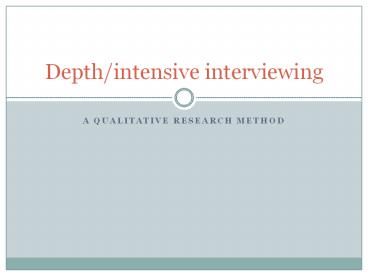A Qualitative research method - PowerPoint PPT Presentation
1 / 17
Title:
A Qualitative research method
Description:
Preparing for the interview. Study the topic. Know the language used to describe the content area. Know about the respondent, if possible. Plan an outline of topics ... – PowerPoint PPT presentation
Number of Views:47
Avg rating:3.0/5.0
Title: A Qualitative research method
1
Depth/intensive interviewing
- A Qualitative research method
2
Depth/intensive interviews
- An interview is a conversation between a
researcher (someone who wishes to gain
information about a subject) and an informant
(someone who presumably has information of
interest on the subject). - (Berger, Media and communication research methods)
3
Intensive interviews
- Intensive interviewing relies on open-ended
questions to develop a comprehensive picture of
the interviewees background, attitudes, and
actions - Open-ended questions
- Varies from structured to unstructured
- Interviews tend to be lengthy
- May be hours in length
- Becomes like a directed conversation
- Requires active probing of responses
4
Why use depth/intensive interviewing?
- When you are uncertain what the most significant
issues in an area of study are, a depth interview
with an expert or a typical group member can be
especially valuable - Few assumptions prior to gathering data
- Get as much information as possible from
especially valuable sources - Information-rich method
5
Why use depth/intensive interviewing?
- Can gain insights you had not imagined prior to
the interview - Often respondents will hit you with something you
had not expected - Can follow the internal logic of respondents
thinking rather than imposing one from outside - Map the ways that people form their understanding
of the topic - Can learn the actual language, etc. respondents
use to discuss topics
6
Why use depth/intensive interviewing?
- Depth interviews allow for the development of the
greatest levels of rapport between interviewer
and respondent - If respondent is uncomfortable or unwilling to
provide information in other formats, this may be
the best way to gather that info - Greatest interviewer ability to help/guide the
respondent - Respondents with limited language skills,
uncertainty of research protocols, etc.
7
Why use depth/intensive interviewing?
- Experts/famous people, etc. may be unwilling to
sit still for traditional closed-ended
questionnaire - The depth interview format often suits them,
allows them to demonstrate their expertise - Much of what they gain from the research is that
opportunity to demonstrate their knowledge - Recognition of their knowledge and expertise
8
Whats the catch?
- The intensive interview demands a great deal of
time and effort - It is not easily passed along to professional
data collection providers - Need for significant knowledge/understanding to
carry out the interview - Potential for bias is great
- Safety concerns are real in some cases
- Data analyses are difficult and time-consuming
- No two interviews are identical, so adding up
responses is difficult and perhaps invalid
9
Preparing for the interview
- Study the topic
- Know the language used to describe the content
area - Know about the respondent, if possible
- Plan an outline of topics to cover in an
interview - Grand tour questions open ended questions that
are designed to elicit lengthy narratives
10
Preparing for the interview
- Be ready to begin interviewing at any point from
initial contact on - Provide a compelling reason why the person should
be willing to talk to you - Expert respondents could tell you I make 1,000
an hour and you are on the clock
11
Sampling
- Random selection of informants is rare
- Typical group members
- Experts
- Demanding respondents
- Select interviewees who
- Are knowledgeable on the subject of interest
- Are willing to talk
- Represent a range of perspectives from within a
group
12
How many interviews do I need?
- Selection of new respondents should continue
until a saturation point is reached, that is,
until new interviews yield little additional
information
13
Establishing and maintaining rapport
- Do not violate standards of social behavior
- Show respect for interviewee
- Do not react in a negative manner to what she/he
says - Demonstrate your appreciation for the time and
effort the respondent provides you - Assure the informant of confidentiality
- Early in the interview, explain clearly the
purpose of the interview
14
Asking questions and recording answers
- Plan questions around an outline (but be flexible
in order) - Make questions short and to the point
- Use nondirective probes
- Follow-up questions should be tailored to answers
- Clarifications should be specificnot What do
you mean? - When a respondent is on a roll do not try to
change direction - Unless the respondent is simply repeating
himself/herself
15
Data collection
- Tape recorders are a good idea and usually are
ignored - Constant note-taking is a distraction
- However, some respondents will give away good
information when the tape recorder gets turned off
16
Triangulation
- Combining participant observation and intensive
interviewing can deepen understanding - May follow up experiment with depth interviews
- May call back selected survey participants to
conduct depth interviews - Etc.
17
- Sources used
- Schutt, R. K. (2004). Investigating the Social
World, (4th ed.). Thousand Oaks, CA Pine Forge.































